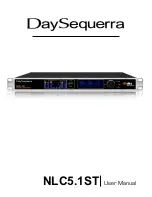
10
NLC5.1ST User Manual
Bronwyn Jones and Emil Torick created a revised CBS loudness meter in the early 1980s that
consisted of eight filters, each covering three critical bands. This approach did prove to deliver better
subjective modeling than traditional SPL or RMS measurements (Jones & Torick, 1982).
In 2004, Nielsen and Skovenborg published an AES paper that expanded upon the ideas of critical
band loudness measures. This paper introduced a method called HEIMDAL, which separated spectra
into nine bands via an octave filter band. While the HEIMDAL multi-band model did not achieve the
complexity of cochlear modeling as shown by J. Allen, the method had the lowest error compared to
any preceding loudness models (Nielsen & Skovenborg, 2004).
Despite the clear benefits of critical band analysis in loudness measurement, there are very few
methods currently available to measure loudness this way in real-time for broadcast applications -- the
extra processing required to accomplish it have prevented widespread adoption. DTS Neural Loudness
Measure is the first real-time perceptual loudness measurement product available that embraces this
advanced approach to loudness measurement.
Absolute Error (dB) of various loudness measures
Critical band comparison between loudness measures
Summary of Contents for NLC5.1ST
Page 1: ...NLC5 1ST User Manual...











































